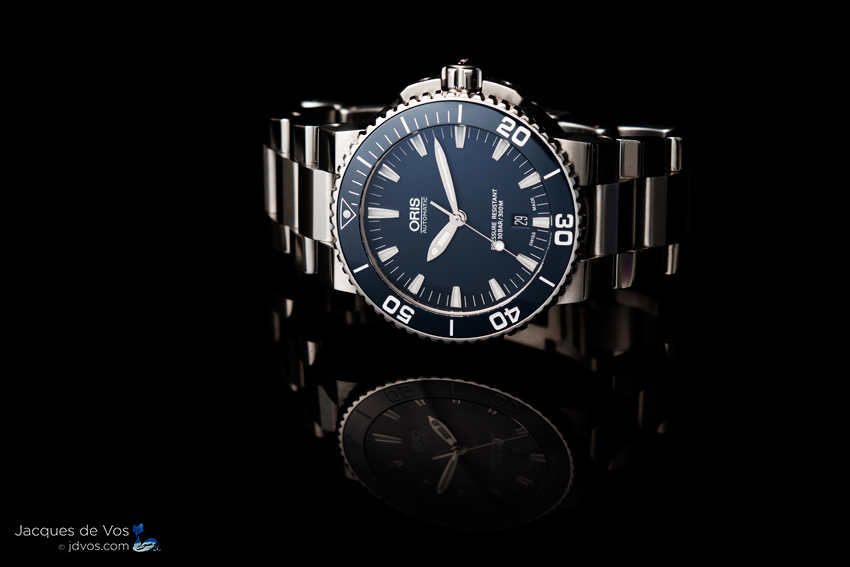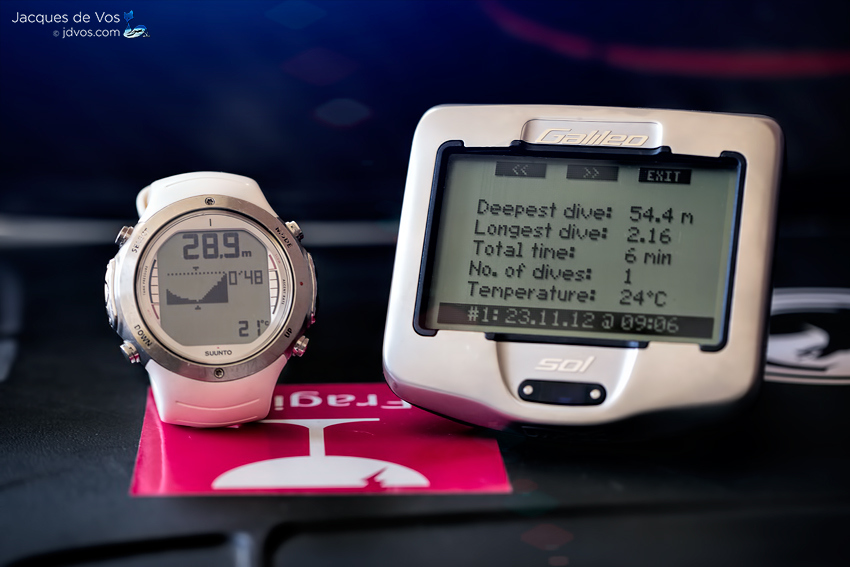25
Feb 2015
Dive Watch vs Dive Computer
What is the difference between a dive watch and a dive computer?
As a child I was obsessed with anything related to the ocean, especially if it was underwater and long before I started diving I had seen enough James Bond movies featuring Rolex, Breitling and Omega dive timepiece, as well as ads for beautiful analogue dive watches in magazines and newspapers to ‘know’ that if you were going to be a real diver you needed a fancy analogue dive watch to fit the part.

“Tell the world you’re a diver with the most famous name in dive watches…Doxa”
This idea was enforced even further in my childhood as the son of an Admiral where I was awestruck by the South African Navy Divers who were issued black Rolex Submariners (later Tudor Sub) as part of their issued gear. Further down the road my obsession with the ocean (and co-currently dive watches) sparked an interest in older sources going back to Jacques Cousteau’s early series Rolex Submariner in the 1955 ‘The Silent World’ and his fellow explorers like André Laban sporting the first series Blancpain dive watch. In later years the Cousteau documentaries also featured the Aquastar Deepstar and Doxa series of dive watches very prominently and eventually the Omega Seamaster (most notably the Seamaster 1000).

Cousteau era Blancpain and Aquastar dive watch ads.
This was undoubtedly the start of my love of fine analogue dive timepieces but I would only later learn how limited the functionality of these watches actually were in comparison to dedicated dive computers when used for either professional or recreational scuba diving or freediving.
So what is the difference?

From left to right,Two variants of a dive computer along with a standard automatic dive watch
Dive Watch (Analogue)
A dive watch or timepiece is essentially a depth rated timepiece whose main function is to keep track of time. Generally speaking the most common features include:
– a water resistance typically expressed as a depth rating of 200 to 300 m (660 to 980 ft) for scuba diving.
– usually (but not always) an external or internal rotating diving bezel of which the original function was to mark minutes in accordance to dive tables to help calculate a divers bottom time.
– Luminous hands which are visible in low light.
– Some dive watches have a helium release valve which provides functionality for professional divers operating at great depths for prolonged periods of time or under saturation.

The authors own Blue Oris Aquis Date.
During scuba diving, a dive watch would be used in combination with a separate analog pressure gauge to adhere to a pre-planned dive profile which is usually noted on a dive slate as reference.
Some modern dive watches like the Oris Aquis Depth Gauge take it a step further and have the added benefit of a simple depth gauge on the face of the watch which is usually effective and marked to 100 meters (330ft). Others like the Ball Engineer Master II Diver TMT have a temperature gauge and an additional yet elaborate piece like the Vulcain Nautical Trophy feature decompression tables on the face although watches with this function tend to be quite rare.

The Vulcain Nautical Trophy features decompression tables which are adjusted using two crowns.
Dive Computer:

Suunto D6i And Galileio SOL dive computers.
A dive computer is a device used by an underwater diver to measure the time and depth of a dive in real-time. In scuba diving this is important so that a safe ascent profile can be calculated and displayed so that the diver can avoid DCS (decompression sickness). In 1985 The Hans Hass Deco-Brain was the first electronic dive computer and also the forerunner for the devices in use today.

The Deco-Brain was the first electronic dive computer.
The following information can be displayed on a typical modern day dive computer using LCD displays:
– Dive planner (to plan a dive a profile before entering the water).
– Current depth.
– Water temperature.
– Ascent rate (with alarms to warn diver to stay within ascent rate limit).
– Maximum depth reached on the dive
– The time remaining at the current depth without the need for decompression stops on ascent (also called the no stop time).
– Total dive time
– Decompression stop depth and time (if required).
– Dive profile which can be viewed after the dive to analyse the whole dive in detail.
– No Fly Time (display showing when the diver can safely board an airplane after scuba diving).
In addition to these features, some more advanced computers allow for gas mixtures and might even use a sensor which connects directly to the diving cylinder and relays the gas pressure, estimated remaining air time based on the available gas as well as the rate of consumption.
In competition or depth freediving a freediver tries to minimize movement and increase streamlining and therefore does not normally look at their dive computer during the dive so it is used to record the dive log information for post dive viewing. However, one of the important functions a dive computer has for a freediver is its use of depth alarms or notifications, prompting the freediver to perform certain tasks or giving them an idea of stages (depths) without having to see the computer.

Freedivers often wear dive computers close to the head in order to hear depth alarms easier while diving.
The Dive Watch in Modern Diving.
Given the brief comparison above, what place does a analogue dive watch still hold in modern diving?
The most feasible reason is that some modern day professional divers (most notably commercial divers) still use a classic dive watch in combination with a dive computer as a ‘back-up’ reference timepiece should one fail. Given the depths at which saturation divers can operate this requires extreme timepieces and some take it to almost unpractical extremes like the stunning oil filled Sinn UX SDR which has a depth rating of 12 000m ( 39 400 ft).
Sadly the reality is that the days of a dive watch being the primary device for monitoring depth and time for scuba or saturation diving is long since gone.
Despite this, analogue dive watches have a definite timelessness and appeal and for many modern dive watches have become something of a status symbol. When viewing the marketing behind some of the most sought after names in dive watches, there is a constant throwback to the theme outlining an age of exploration and the sense of adventure generated by individuals like Jacques Cousteau.

Rolex Ads: Then and Now – The spirit of exploration and adventure…
Modern examples include Rolex ambassador and underwater photographer David Doubilet, Oris athlete and Freediver Anna von Boetticher and previously Breitling’s Ambassador as well as the world’s deepest man, Herbert Nitsch. Few can argue that having a dive watch on your wrist somehow, diver or not, gives the wearer a connection to that sense of exploration.
Having been in the dive industry for several years I can quite easily count on one hand the amount of divers who still relied solely on a dive watch and pressure gauge for scuba diving. Spend time on beaches or in expensive resorts along the French Riviera or even next to the Red Sea and amazingly enough you will see many ‘well off’ individuals on a short diving retreat or holiday sporting anything from a USD 135,000 Richard Mille Automatic Chronograph Diver or the ‘cheaper’ two tone Gold and Azur Rolex Submariner (USD 12,000) on a dive. It can be argued that this is often nothing more than a conversation starter or status symbol for those who can afford it but it is not uncommon to see the more affordable Seiko Prospex or even Omega Seamaster on a divers arm and in these cases it usually has more to do with a form of nostalgia or affection for the watch rather than some definite practical reason.

At 135 000 USD the Richard Mille Automatic Chronograph Diver is one of the most expensive ‘dive watches’ available.
So where do dive watches still outshine dive computers?
On land
I have yet to see a full functioning dive computer which comes close to the aesthetic appeal of a beautiful automatic analogue dive watch. As someone who loves fine timepieces, I tend to wear my dive computer (a Suunto D6i which also works just like a watch) only when actually doing any proper diving requiring the myriad of functions associated with it and the rest of the time I wear a watch (currently the beautiful Oris Aquis date) for the simple reason that it is a pleasure to wear and it looks awesome. Its hard not to think of the James Bond sitting at the poker table wearing a tailored tuxedo with his signature Omega Seamaster on the wrist…
In the water
As an underwater photographer and cameraman who spends most of my time shooting while freediving I am often in situations where I don’t need to pass extended times at depth and sometimes spend more time snorkeling to film large marine life closer to the surface with occasional shallow dives. In these instances simply jumping into the water with a dive watch which is your daily wearer is practical and this also goes for swimming or any in water activities where I have no need for all the functions associated with a dive computer. Often while swimming and doing shallow breath hold dives all you need to know is the time and it doesnt hurt that a dive watch looks great in the water too.
Jacques de Vos filming wild bottlenose dolphins in Mozambique. Video: Emil Sergel
Summary:
Although its clear that the functionality of analogue dive watches as a tool for scuba diving or even Freediving has been replaced by the advent of the dive computer, the dive watch definitely still has its place in the water and has a timelessness both in and out of the water which will keep it alive for many more generations of divers and would be divers to come.
